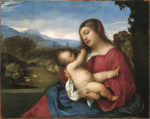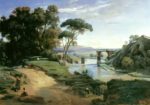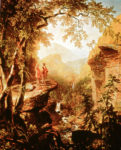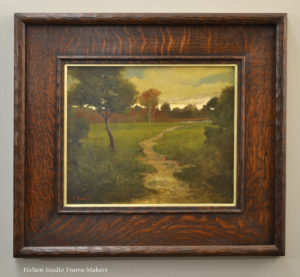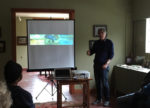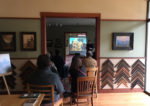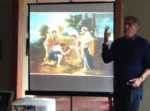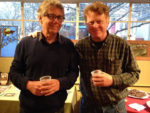This past Saturday afternoon at the Gallery, Paul Roehl gave a very informative and engaging talk called “Beyond Representation: The Poetic Landscape.” (This was part of our highlighting Paul’s work through March 18.) One concept in particular resonated for me: “protection and prospect”. The phrase describes a wide view of a landscape from a relatively sheltered standpoint. Examples from Paul’s own work are in the text below. Here are some good historical examples—
- Titian, “Madonna and Child in a Lanscape”
- Wang Hui (1632–1717), The Kangxi Emperor’s Southern Inspection Tour, Scroll Three: Ji’nan to Mount Tai
- Jean-Baptiste Camille Corot, “View at Narni”
- Asher B. Durand, “Kindred Spirits”
Paul described this idea as a compositional device—a compelling arrangement of the picture’s perspective, with a place of safety and shelter where the viewer is, against a wider and more wild and rugged distant land beyond. The sense of protection can be clearly and explicitly suggested by, for example, the posts and railing of a front porch, placing the viewer on the porch; or a fence that puts us in a protected yard. It can be a whole house or cottage or barn or cozy grove of trees in the near ground. It might be a boat landing or pier, or platform of a train station. But often it’s more subtle, and implied by nothing more than a shadow in the foreground, cast, we can assume, by a protecting tree, steep hill or large rock. In a very rugged landscape, even just an unusually level spot provides a place of rest and relative safety—just good enough for the painter to set up an easel! For Paul, a simple footpath—a safe way forward, a human imprint and presence on the land—seems to provide the relative protection. The vista or “prospect” beyond is a broad and often awe-inspiring, ruggedly hilly or mountainous, usually highly varied landscape, its beauty evoking feelings of hope and opportunity. The “protection” and “prospect” aspects of the picture are emotionally complementary—the safety of the close and familiar shelter or refuge felt more intensely juxtaposed to the dauntingly wild prospect, and vise-versa.
(When I asked Paul later the origin of this idea, he pointed me to the “prospect-refuge thesis” derived by Jay Appleton in his 1975 book, The Experience of Landscape. More here…)
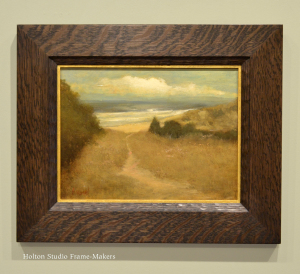
Paul Roehl, “Beach Trail” (sold)
What’s compelling about this idea for painters is the deeply, viscerally satisfying effect it has on the viewer—a sense it provides of security and of being settled, if only temporarily, in a place where one can comfortably survey the outlook. Its power seems due to its tapping into an innate human longing for both security in a protected, personal space, but also a sense of access to a wider world offering purpose and possibility—for a certain equilibrium in our sense of place in the world. The human creature is simply not made for exposure to nature’s elements, even in the mildest climates. (Recognizing this helps us appreciate the horrors of being homeless.) But at the same time, being imbued with imaginations and agency, we long for the broader view and prospect that provides a range for the imagination and sense of possibility, adventure, and hope.
There’s no question that the idea invites cliche treatment as well as disparagement of it as a theory leading to unsophisticated “safe” art that’s calculated to make us comfortable instead of challenging us. But no matter how sophisticated we like to think ourselves, it’s hard to deny the primal need such a compositional approach addresses. Perhaps above all it answers our eternal quest to establish harmony between human civilization and nature, to place ourselves wholesomely in the wider creation.
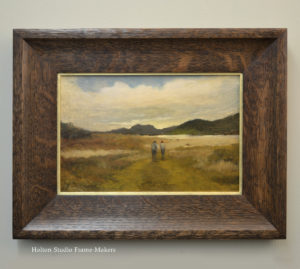
Paul Roehl, “North Coast Hike,” more…
Seems likely that painters have used this approach but with something different from a sense of optimism and potential implied by the word “prospect.” Looking at the historical examples above, while “prospect” might describe what the Hudson River School painters were expressing—an opportunity, possibly purely economic, as human commerce and habitation took over the land in the nineteenth century—in Titian’s Madonna painting, the landscape feels more like simply God’s creation, viewed with nothing more than awe and veneration. In the former case, the view is a spur to action; in the latter, grounds for contentment and peace.
Paul’s talk got me thinking about the frame’s role in all this—and arriving at revelations about my trade of over forty years that had never dawned on me until now! I’ll discuss that in my next post.
Again, Paul Roehl will be highlighted at The Gallery through March 18.
View Paul’s page on our website…
